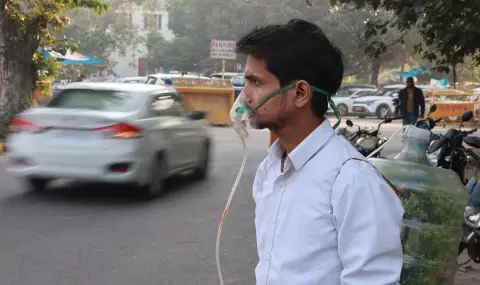Promila Bhutani lives in New Delhi. The famous pediatrician suffers from asthma and fears the heavy smog in the Indian capital. She has already been hospitalized twice this year due to poor air quality.
"Last week I was supposed to travel to Mumbai for an important event. On the way to the airport, I was wearing a mask, but before I even reached the airport, I felt unwell and had to cancel the trip," she told DW.
Cough and panic attacks
Auto-rickshaw driver Manish Paswan is also battling severe coughing fits. "The last few days have been terrible - I have serious breathing problems. I am having panic attacks and I hope the doctors can help me", he told DW.
The recently opened Center for the Treatment of Diseases Caused by Dirty Air has quickly become a lifeline for people with respiratory problems. Doctors confirm that cases of shortness of breath, asthma or chronic obstructive pulmonary disease (COPD) have increased. This year they have treated more patients than in the previous year. "The elderly and people with heart disease are particularly at risk. They show more symptoms and have to be hospitalized", Kailash Gupta, a lung disease specialist, told DW.
Dangerous fine dust particles
New Delhi has long struggled with air pollution and has the reputation of being the most polluted city in the world. However, experts and doctors warn that air pollution affects not only the capital, but also large parts of India.
The main problem is fine dust particles in the air, especially those with a diameter of 2.5 micrometers. They are small enough to enter the alveoli of the lungs.
The problem goes beyond the boundaries of individual administrative and economic regions in India. Agriculture, industry, power plants, households and transport contribute significantly to air pollution in India.
Pediatricians sound the alarm
A study published in 2021 found that nearly 1.7 million deaths were due to air pollution in 2019. This is the highest mortality rate in the world associated with polluted air. According to the study, this is also added to economic losses totaling 36.8 billion $.
“Air pollution is also having a huge impact on India's younger generation,“ says Philip Landrigan of Boston College's Global Pollution Observatory. “For today's children, it increases the risk of heart disease, diabetes and respiratory diseases as adults. And dirty air lowers children's IQs. It will be much harder for India to develop socially and economically if nothing is done to tackle the problem,“ the pediatrician warns.
“A silent epidemic“
A recent study has linked air pollution to an estimated 2.1 million deaths a year in the world's most populous country. “Every day in India, 464 children under the age of five die as a result of air pollution. "This has overtaken smoking and diabetes as the leading cause of death," the report highlights.
Surgeon Arvind Kumar describes air pollution as a silent epidemic. "We have serious and unacceptable levels of air pollution, which is not only affecting people's lives but is also destroying ecosystems. No one can escape the negative effects of this polluted air, it affects every organ in the body," he warns.
Kumar has closely observed the growing effects of air pollution on his patients. This has prompted him to set up a non-profit organisation, the Lung Care Foundation. "The data is telling, but nothing is being done to address the causes of pollution," he laments.
What can be done?
According to the World Bank, in areas where a significant proportion of air pollution particles exceed 2.5 micrometers, India will need to take comprehensive measures. It needs a new set of tools," the World Bank writes.
“Doctors for Clean Air“ is a network of medical professionals who are fighting to improve air quality. To this end, they raise awareness about the health effects of pollution and try to get people living in the most affected regions to engage more actively in this cause.
“It is now clear that citizen initiatives and movements are the most effective. It takes time, but it gives results“, Dr. P. S. Bakshi tells DW. He gives the example of farmers in the village of Bajra in the Indian state of Punjab. Like many other villagers in northern India, those in Bajra burn the remains of straw and stubble after harvesting rice and wheat. This is a quick and cheap way to prepare the fields for the next sowing season, but it also contributes to air pollution.
After Bakshi explained to the local population the negative health effects, the farmers in Bajra agreed to stop this practice. "Now the number of farm fires in Punjab has come down significantly, but more needs to be done to change the awareness about health and air quality," the doctor stressed.
Author: Murali Krishnan
